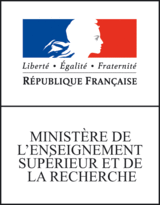Rules set ⬅️ • ⬆️ • ➡️ Confluence
Grew Tutorial • Lesson 4 • Termination
One key problem that may arise when using rewriting is the non-termination of the process. Let us look at a few examples and how we can deal with it in Grew.
In previous lessons, we have considered the conversion of Sequoia POS tags to SUD POS tags for some tags (adjectives, nouns and prepositions).
A stupid looping rule
Consider now adverbs: the same tag ADV is used in both annotation settings.
We can then imagine the (somehow stupid) rule adv (file: adverb.grs):
rule adv {
pattern { X [upos=ADV] }
commands { X.upos = ADV }
}
Then apply it to our input graph, first alone and then with the Onf strategy:
grew transform -config sequoia -grs adverb.grs -strat "adv" -i frwiki_50.1000_00907.seq.conll
grew transform -config sequoia -grs adverb.grs -strat "Onf(adv)" -i frwiki_50.1000_00907.seq.conll
The fist command returns a graph which is identical to the input one: there is exactly one ADV in the input graph, the rule is applied to it and replaces ADV by ADV!
Now, the second command tries to apply the rule iteratively and stops when no more rules can be applied… but the rule can always be applied again and again at the same place. The computation is not terminating. Fortunately, Grew tries to help us and provide the following error:
Grewlib error:
More than 10000 rewriting steps: check for loops or increase max_rules value. Last rules are: […adv, adv, adv, adv, adv, adv, adv, adv, adv, adv]
Grew tries to track the non termination problem with a bound on the number of rule applications (by default 10000) and stop the computation when the bound is reached. The error message also gives the name of the last ten rules applied before the bound is reached to help us understand the problem.
The solution here, is of course to remove this rule which is useless, but more complicated cases may occur!
Another looping rule
Let us come back to our input graph:
and consider the conversion of the Sequoia POS V.
In SUD (like in UD), this tag should be converted to AUX or to VERB.
One way to decide that the new POS must be AUX is the presence of the relation aux.pass.
We can propose the rule (file: aux_1.grs):
rule aux_1 {
pattern { X -[aux.pass]-> Y }
commands { Y.upos = AUX }
}but this rule will also produce an error if it is iterated: after the first application, the request { X -[aux.pass]-> Y } is still present in the graph and the rules can be applied again and again.
Solution 1: make a stricter request
With the rule aux_2 (file: aux_2.grs), the request cannot be found after the first application and there will be no loop.
rule aux_2 {
pattern { X -[aux.pass]-> Y; Y [upos=V] }
commands { Y.upos = AUX }
}Solution 2: use a without clause
The rule aux_3 (file: aux_3.grs) shows a more general trick which can be used in similar cases: add a without clause which explicitly contradicts the commands part.
rule aux_3 {
pattern { X -[aux.pass]-> Y }
without { Y [upos=AUX] }
commands { Y.upos = AUX }
}Termination in general
Of course, in a more general setting, we can have loops which imply more than one rule and which are more difficult to manage. Unfortunately, it is not possible to decide algorithmically if some rewriting system is terminating or not.
Anyway, in NLP applications like conversions from format A to format B, it is often easy to ensure termination as we have a kind of measure which stands for the fact that we are closer to the B format after each rule application. For instance, in all the non-looping rules above, if we count the number of Sequoia POS tag in the graph, it is strictly decreasing at each rule application.




